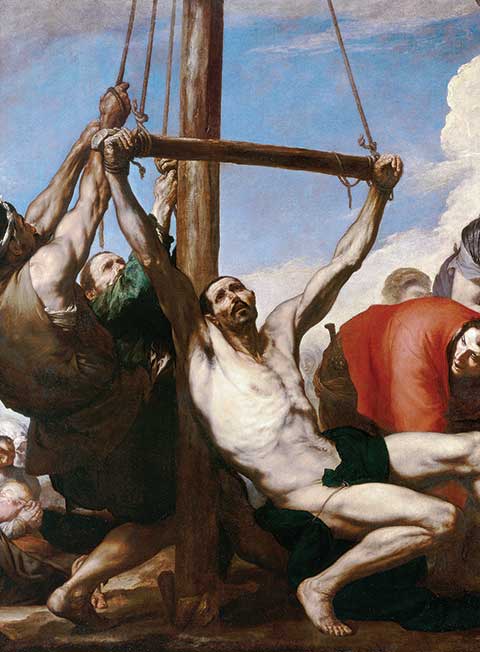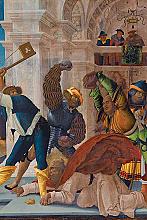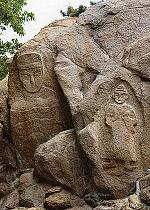Partners in mission

[ABOVE: Jusepe de Ribera, The Martyrdom of Saint Philip. C. 1639. Oil on canvas—Museo del Prado / Public doman, Wikimedia]
The Lycus River valley forms a plateau in southwestern Asia Minor as a valley between two mountain ranges. Its rich, well-irrigated volcanic soil made it a prosperous area and gave rise to the cities of Colossae, Laodicea, Tripolis, and Hierapolis.
Perched upon the dazzling white travertine cliffs of a low volcanic mountain, Hierapolis—meaning holy or sacred city—was the valley’s crown jewel. Nine miles to the north of Laodicea, the city boasted of natural pools and channels from its geothermal hot springs. People from all over would travel there, prizing the healing properties of the springs.
High above the city are the remains of the octagonal-shaped martyrium of St. Philip the Apostle, dated to the fifth century. A martyrium is a church built upon or near the site where the martyrdom occurred. In 2011 Francesco D’Andria, an Italian archaeologist, discovered the tomb of Philip about 40 yards to the side below the martyrium. Here the missionary legacies of Philip and Bartholomew, Philip’s fellow apostle and partner, began and perhaps also ended.
PHILIP THE EVANGELIST?
The earliest Christian tradition locates Philip and his virgin daughters in Hierapolis. Eusebius, in his Church History, quotes sources that confirm this; however, he also identifies this Philip as Philip the Evangelist (or Deacon), one of the seven deacons set apart for ministry (Acts 1:13; 6:5), whose daughters had the gift of prophecy. By the end of the second century, Christian tradition appears to conflate Philip the Apostle and his virgin daughters with Philip the Evangelist and his prophetess daughters. Some suggest only one Philip existed, who was both an apostle and an evangelist, but this seems unlikely due to the differing roles of Philip the Apostle and Philip the Deacon.
Regardless, a clear consensus emerged placing Philip the Apostle and his daughters in Hierapolis, with the most detailed account of his ministry and martyrdom coming from the Acts of Philip. This apocryphal text is a hagiography, or biography of a venerated saint, with a varied textual and reception history. Most likely the text was written in the fourth century, a period that witnessed the condemnation of the Encratite communities of Asia Minor. The Encratites, a Christian sect later deemed heretical, renounced wealth, denounced marriage, and practiced celibacy. In the Acts of Philip, much of the preaching includes instructions to remain pure, avoid marriage, and remain celibate.
The text contains a total of 15 acts chronicling Philip’s ministry in Galilee, Athens, Parthia, Azotus, Nikatera, and in the wilderness; it ends in Ophioryme (Hierapolis), where the fifteenth act recounts his martyrdom. The unusual name Ophioryme for Hierapolis means “promenade of the serpents” because they worshiped the mother of serpents called the Viper—possibly Cybele, a goddess of Asia Minor. In this story Philip is accompanied by his sister Mariamne, Bartholomew, a talking leopard, and a talking goat. They entered the city, passing seven men guarding the city with snakes that would bite strangers, and at the city gate they defeated the two dragons that spewed poisonous vapors causing blindness.
Philip, Bartholomew, and Mariamne then established a spiritual healing center. There they healed a man named Stachys who had been blind for 40 years. His healing prompted Nicanora—a woman also suffering from eye problems and the wife of the governor Tyrannognophos—to hear Philip’s words, resulting in her salvation and healing. When Governor Tyrannognophos found out about her conversion, he responded with rage and dragged her out of the house. He then arrested Philip, Bartholomew, and Mariamne and had them beaten with rough straps of leather. Then he bound them by their ankles and dragged them across the city to the gate of the temple of the Viper. The governor also ordered them to be stripped naked, but when they stripped Mariamne, a bright cloud of fire surrounded her, obscuring her nakedness.
PHILIP’S FATE
The governor’s soldiers brought large iron hooks and skewered them through Philip’s heels and ankles. They hoisted him upside down from a tree in front of the Viper’s temple. Then they did the same to Bartholomew, nailing his hands to the temple gate. At this point the apostle John entered the city and encouraged Philip to forgive the people and follow Jesus’s example to not return evil for evil. Philip being angry, however, ignored the urging of John, Bartholomew, and Mariamne and uttered a curse upon the people.
At his curse the ground opened in the temple and swallowed over 700 people, including Tyrannognophos. Jesus appeared to Philip rebuking him for his curse. Jesus informed Philip that because of this he would not be allowed to enter paradise for 40 days, but then he would be admitted. He also said that Bartholomew would be released to continue his ministry but would be martyred in Lycaonia. Likewise, Mariamne would continue but would be martyred when she was thrown into the Jordan River. Jesus then rescued all those who fell into the pit by making a sign of the cross that became a ladder for them to climb out, but Tyrannognophos refused. The crowd of believers tried to release Philip, but he told them to release Bartholomew instead, and he appointed Stachys as bishop of Hierapolis.
This tradition surrounding Philip’s ministry and martyrdom leaves us with several questions. The earliest traditions make no mention of his martyrdom, but they do indicate Hierapolis as his final resting place, and the martyrium coupled with the recent discovery of Philip’s tomb further supports the early traditions. Given the date and legendary characteristics of the Acts of Philip, the circumstances around his ministry with Bartholomew and his death might retain a kernel of historical basis, but they are suspect at best.
BARTHOLOMEW’S STORY
Bartholomew, also known as Nathanael (see pp. 11–13) and associated with Philip in John 1:45, became Philip’s partner in Hierapolis. He stars in several of his own apocryphal acts, which report five different accounts of his martyrdom. The Acts of Philip ends with Bartholomew’s rescue from crucifixion in Hierapolis, his departure to Lycaonia, and the prediction of his crucifixion there. Elsewhere, in the Preaching of St. Bartholomew in the Oasis, the allotment fell to Bartholomew to evangelize Egypt. After miracles—healing one man of blindness and a rich man of a snake bite—he gathered a congregation of believers. The rich man built a church, and Bartholomew appointed him as a priest before leaving for his next destination.
According to the Encratite document, Martyrdom of Bartholomew, this next destination was Naidas, located upon the shore of Parthia to the east of the Roman Empire. There he successfully preached the Beatitudes and healed a man of his blindness and his withered hand. However, when he told married women, including the queen, to live with their husbands without sex, King Agrippus commanded the apostle’s execution. Soldiers filled a sack with sand, put Bartholomew in it, and threw it in the sea. The next day, the body washed ashore and the believers gave him a proper burial.
Yet another account, the Martyrdom of the Holy and Glorious Apostle Bartholomew, placed Bartholomew’s death in India. After Bartholomew arrived in the deepest, darkest region of India, he confronted demons, who were deceiving the people by alternatively sickening and then healing them. Bartholomew confounded the demons with a ministry of healing in the name of the true, almighty God.
An interesting feature of this account is the demon’s description of Bartholomew in the Passion of Bartholomew: “He has black hair, a shaggy head, a fair skin, large eyes, beautiful nostrils, his ears hidden by the hair of his head, with a yellow beard, a few grey hairs, of middle height, and neither tall nor stunted, but middling.” Although most of the king’s family were converted and baptized, the king’s brother Astreges refused Bartholomew’s God. He challenged Bartholomew to prove that his God was greater, and immediately Astreges’s idols were cast down. In anger he commanded that Bartholomew be beaten and beheaded.
BARTHOLOMEW’S MANY DEATHS
Bartholomew’s possible ministry in India receives corroboration from Eusebius in his Church History and Jerome in Lives of Illustrious Men. Both church fathers reported that when Pantaenus the philosopher traveled to India, he discovered that the apostle Bartholomew had preceded him (see also Hippolytus, On the Twelve).
And yet one more tradition remains; this one places Bartholomew in Armenia, an ancient country north of Parthia. According to Tertullian and Bishop Dionysius of Alexandria, there existed a considerable Christian community by the second and third centuries, and by the fourth century, Armenia entirely converted to Christianity. Details about Bartholomew’s martyrdom in Armenia were recorded late, but several sources reported that he was flayed alive before being either crucified or beheaded.
Bartholomew’s legends placed him in a variety of locations: Hierapolis and Lycaonia, in Anatolia; Egypt; Parthia; India; and Armenia. His martyrdoms were also varied: he was crucified, drowned, beaten, beheaded, and flayed. What we can know with confidence about both Philip and Bartholomew is that they followed Christ’s commission to “go into all the world and preach the gospel to all creation” (Mark 16:15). CH
By Alan S. Bandy
[Christian History originally published this article in Christian History Issue #156 in 2025]
Alan S. Bandy is the Robert L. Hamblin Chair of New Testament Exposition at New Orleans Baptist Theological Seminary.Next articles
Sons of Alphaeus
Facts and myths About “brothers” Matthew and James, disciples of Jesus
Thomas G. Doughty Jr.“Doubting” or “daring” Thomas?
History’s most famous doubter recovered his faith and pioneered a bold mission to the East
Bryan M. LitfinSupport us
Christian History Institute (CHI) is a non-profit Pennsylvania corporation founded in 1982. Your donations support the continuation of this ministry
Donate







